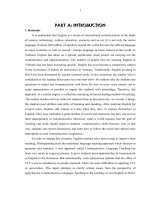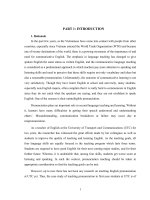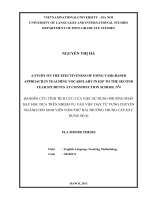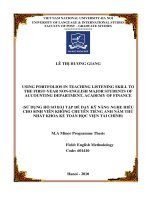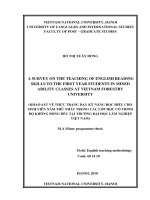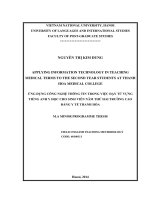Teaching english vocabulary to the first year students at nghe an trading and tourism vocational college
Bạn đang xem bản rút gọn của tài liệu. Xem và tải ngay bản đầy đủ của tài liệu tại đây (3.52 MB, 78 trang )
MINISTRY OF EDUCATION AND TRAINING
VINH UNIVERSITY
NGUYEN THI LAN HUONG
TEACHING ENGLISH VOCABULARY TO THE
FIRST-YEAR STUDENTS AT NGHE AN TRADING AND TOURISM
VOCATIONAL COLLEGE
MASTER’S THESIS IN EDUCATION
Nghệ An, 2014
MINISTRY OF EDUCATION AND TRAINING
VINH UNIVERSITY
NGUYEN THI LAN HUONG
TEACHING ENGLISH VOCABULARY TO THE
FIRST-YEAR STUDENTS AT NGHE AN TRADING AND TOURISM
VOCATIONAL COLLEGE
Major: Teaching English to Speakers of Other Languages (TESOL)
Code: 60140111
MASTER’S THESIS IN EDUCATION
SUPERVISOR: NGUYEN GIA VIET, Ph.D.
Nghệ An, 2014
STATEMENT OF AUTHORSHIP
I certify that the thesis entitled “Teaching English vocabulary to the first-year
students at Nghe An Trading and Tourism Vocational College” is the result of
my own work, and that the thesis or my any parts of the same has not been
submitted to any university or institution.
Vinh, August 2014
Author’s signature
Nguyen Thi Lan Huong
i
ACKNOWLEDGEMENTS
I would like to express my deepest gratitude to my supervisor, Dr. Nguyen
Gia Viet, for his kind help, careful guidance, valuable advice and
encouragement from shaping the first draft till the completed thesis.
I am also grateful to the head of Foreign Language Department of Nghe An
Tourism-Trading Vocational College, Mrs. Le Thi Mai Hong, my colleagues
and students of K18D1 and 18D2 who helped me much to finish the
methodology of the research.
I wish to thank my parents and my loved family who love, care and support
and encourage me a lot in the production of this study.
Finally, I am too aware that despite all the advice and assistance, I fell that the
thesis is far from perfect, it is, therefore, my sole responsibilities for any
inadequacies that it may be considered to have.
ii
ABSTRACT
Students at Nghe An Trading and Tourism College have many difficulties in
learning English Vocabulary. “How to help students to learn vocabulary
better?” is always a question for teachers at Nghe An Trading and Tourism
Vocational College. To improve vocabulary learning and teaching, two
questionnaires are designed and directed to 70 students and 10 teachers. The
findings discuss the difficulties in teaching and learning vocabulary of both
teacher and students and the methods they use to teach and learn vocabulary.
Simultaneously, some techniques of teaching and learning vocabulary better
are recommended based on the findings of this survey.
iii
TABLE OF CONTENTS
ABERIVIATION…………………………………………………………… … 4
LISTS OF TABLES…………………………………………………………… … 5
LISTS OF FIGURES…………………………………………………………… 6
TABLE OF CONTENTS 1
Chapter 2 10
LITERATURE REVIEW 10
2.1.4. What vocabulary to teach: criteria for selection 14
Learnability 17
2.1.5. Vocabulary in learning English as foreign language 17
2.2.1. Teachers’ beliefs 23
Because investigating teachers’ perceptions about teaching vocabulary is
set under the umbrella of the area of teacher’s beliefs. It is thus important
to understand this area in order to build a vivid theoretical framework
into researching teachers’ mental lives. This section will present
definitions of teachers’ beliefs generally and in the area of language
teaching in particular to ultimately establish an operational definition on
teachers’ beliefs relevant to this study 23
2.2.4. Teachers’ perception of vocabulary teaching 29
Chapter 5 54
CONCLUSION 54
1
ABERIVIATION
ESL: English as a Second Language
EFL: English as a Foreign Language
CLT: Communicative Language Teaching
ELLs: English language learners
TPLD: Teachers’ perceptions of learner difficulty
SLA: Second language acquisition.
%: Percent
2
LISTS OF TABLES
Table 4.1. Perceived contents of vocabulary learning ……………… …… 45
Table 4.2. Students’ knowledge of vocabulary is helpful for their
vocabulary learning………………………………………………………… 47
Table 4.3. Perceived contents of vocabulary learning 48
Table 4.4. Teachers’ knowledge of vocabulary is helpful for their
vocabulary teaching 50
Table 4.5: The methods students usually use in learning vocabulary ……… 50
Table 4.6: The methods teachers usually use in teaching vocabulary 52
3
LISTS OF FIGURES
Figure 4.1. The position of vocabulary in English learning ……………… 44
Figure 4.2. The difficulty in vocabulary learning ………………………… 46
Figure 4.3: The position of vocabulary in language teaching …………… 47
Figure 4.4. The difficulty in vocabulary teaching ………………………… 49
Figure 4.5: Students’ interest in learning English vocabulary ………………51
Figure 4.6: Students’ efficiency evaluation in vocabulary learning ……… 52
Figure 4.7: Teacher’s interest in teaching English vocabulary …………… 53
Figure 4.8: Teacher’s efficiency evaluation in vocabulary teaching …… 54
4
Chapter 1
INTRODUCTION
This chapter is written with the purpose of giving the rationale, objectives of
the study, the research questions, the significance of the study, the scope of the
study, an overview of research methodology and finally introduces the outline of
the thesis.
1.1. Rationale
Recently, English has become an international language which is taught in
many countries all over the world. English is the most commonly used language
among foreign language speakers. By mastering English, people can visit and
communicate with foreign people easily. It is the reason why learning English well
is becoming more and more important.
English in Vietnam is considered as an important language. Children are now
required to learn it from third grade of primary school, and English becomes a
subject which is rather difficult to learn because it is a second language with its
different culture, grammar, pronunciation, etc. Teaching English as a foreign
language is not easy. It is the teacher’s duty to make the students enjoy learning
English because if the students enjoy the learning process, they will easily grasp
what the teacher taught.
In teaching and learning English, vocabulary is the most important factor in
developing the four language skills (reading, writing, listening and speaking).
Therefore, the students are expected to acquire vocabulary in order to express their
ideas, feelings and opinions in speaking and writing. Language elements such as
grammar, vocabulary, pronunciation, and spelling that are taught to support the
development of the four skills including vocabulary are important in the teaching
learning process. Richard (1987, p.45) states that vocabulary and grammar are
essential components of all use of language. It is clear that vocabulary is the main
component in learning English. Myers (1993, p.150) says that the reasons of
5
acquiring a large important vocabulary are the indicative of wide knowledge and be
able to distinguish word by word accurately.
In vocational training school, studying English especially vocabulary is a
compulsory subject. I am myself a teacher in Nghe An Trading and Tourism
Vocational College in Cua Lo Town in which English is focused to help students in
their work in the future. Besides four skills (listening, speaking, reading and
writing), the teachers of English in my college spend more time on vocabulary
because of its importance in learning a language. However, it is not easy to study
perfect English vocabulary. Almost students often face up with some problems in
learning vocabulary. In fact, it is difficult to memorize a new word with its
meaning, spelling and pronunciation, many students are often confused with
knowing how can apply grammar into sentences, sometimes, they cannot
understand when being opposed to video and audio. Moreover, techniques to
teach English is traditional teaching methods and similar activities days by
days, which makes students become fed up with learning English. Therefore,
interesting techniques to teach English are necessary to help students learn English
vocabulary better; they also attract students’ interest on English.
There were some problems that made the students difficult to know the
vocabulary meaning in Nghe An Trading and Tourism Vocational College such as,
some students less knowledge about vocabulary, students’ lack of vocabulary,
students never try to find the new words from a text.
To overcome the problems, the teacher could try some ways to develop
their vocabulary and explore their ideas. In this case, I have the ambition of
presenting some effective techniques to teach English vocabulary with hope
that students will be interesting in learning English. Due to my English knowledge
limitation and the frame of the graduation paper, I would like to choose the
research paper entitle “Teaching English vocabulary to the first-year students at
Nghe An Trading and Tourism Vocational College”.
6
1.2. Aims and objectives of the study
The aims of this study are to find out the difficulties in teaching and learning
English vocabulary, as well as to find the solutions in teaching English vocabulary,
and to find out more techniques in teaching English vocabulary to students at
Nghe An Trading and Tourism Vocational College. The scope of this research is
limited only by focusing on teaching vocabulary. The findings of the study can
inform classroom teachers who are interested in using new techniques in their
vocabulary teaching.
1.3. Research questions
Based on the background of the study above, the questions to answer in this
study are formulated as follows:
1. What are the main difficulties facing the students and teachers in the
process of teaching and learning English vocabulary at Nghe An Trading and
Tourism Vocational College?
2. What are strategies used by teachers and students to overcome difficulties
in teaching and learning English vocabulary?
1.4. Significance of the study
The researcher was conducted with the aim of finding out students’ attitude
towards using some new techniques in teaching English vocabulary.
From that, teachers will know the ways to apply the techniques in their
teaching affectively. The researcher will give the chance for the teachers in Nghe
An Trading and Tourism Vocational College to find out the best methods for
teaching English vocabulary to the first-year students.
1.5. Scope of the study
The study focuses on teaching and learning English vocabulary for the
students at Nghe An Trading and Tourism Vocational College, mainly focus on the
first year students who are learning basic English. Then, the difficulties found out
will be analyzed and the solutions will be made to help to improve the teaching and
learning English at Nghe An Trading and Tourism Vocational College.
7
The study pays its contributions to both theoretical and practical aspects.
Theoretically, by exploring difficulties in teaching and learning vocabulary, the
study adds to the growing demand of strategies for learning and memorizing words
for English language learners (ELLs). Also, by investigating the techniques used to
teach vocabulary within academic settings, it is hoped to provide useful information
about characteristics and benefits of this interesting but less-exploited strategy in
dealing with vocabulary so far.
Practically, the study is hopefully to provide some solutions and recommend
clear guidelines for teachers to deal with vocabulary in particular and, thus, to
facilitate their teaching of English in general. For learners, this study hopefully
provides useful instructions so that they can use them as effective vocabulary self-
learning tips.
1.6. Methods of the study
This study involves 10 teachers and 70 students in Nghe An Trading and
Tourism Vocational College. The study employs survey questionnaire as the
principal method of data collection. Data are analyzed statistically, resulting in
percentage of items. The data are presented in tables and figures in Chapter Four.
More details about research methodology are provided in Chapter Three.
1.7. Organization of the thesis
The study consists of the following parts:
Chapter I. Introduction
This part introduce the issues leading to the study, including rationale, aims,
methods, scope, and organization of the study.
Chapter II: Literature review
Theoretical background relevant to the topic and surveys of articles, books
and other resources relevant to a particular the study topic be presented. This part
also provide description, summary, and critical evaluation of each work quoted.
Chapter III. Methodology
8
This part presents the detailed procedure of the study: the methodology,
population selection, data collection and analysis.
Chapter IV. Findings and Discussions
The part deals with the findings drawn out from the analysis of data. The
findings and discussion are based on the study about difficulties in teaching and
learning English vocabulary and the solutions for these problems.
Chapter V. Conclusion
Main points and contents of the study are summarized based on the results of
the study. The implication of the study and the recommendation for further research
will be presented.
9
Chapter 2
LITERATURE REVIEW
This chapter reviews the literature on teaching vocabulary and teachers’
perception in teaching vocabulary. First, main issues related to teaching vocabulary
as a foreign language are presented, such as the definition, the types and the roles of
vocabulary, etc. In addition, the chapter refers to the perceptions related to
vocabulary teaching. Finally, the chapter states the previous studies of vocabulary
teaching.
2.1. Vocabulary
2.1.1. What is vocabulary?
There are many definitions of vocabulary.
Vocabulary is defined as "all the words known and used by a particular
person" and “all the words which exist in a particular language or subject”
(Cambridge Advanced Learners Dictionary).
According to the Collins Cobuild English Language Dictionary (1989,
p.1629), “the vocabulary of a language is the total number of words in it” and
“someone's vocabulary is the total number of words in a language that he or she
knows”, However, this term will be used in a more restricted sense in this paper: we
will limit ourselves to what Michael Wallace in his work Teaching Vocabulary calls
“content words” as opposed to “structure words”, and which would include nouns,
verbs, adjectives and adverbs derived from adjectives. According to this author,
structure words are almost deprived of mean trip when consider in isolation and,
therefore, should be considered as part of the grammar of a language (Wallace,
1988, p.18).
Another definition of vocabulary: vocabulary is knowledge of words and
word meanings. However, vocabulary is more complex than this definition
suggests. First, words come in two forms: oral and print. Oral vocabulary includes
those words that we recognize and use in listening and speaking. Print vocabulary
includes those words that we recognize and use in reading and writing.
10
Second, word knowledge also comes in two forms, receptive and productive.
Receptive vocabulary includes words that we recognize when we hear or see them.
Productive vocabulary includes words that we use when we speak or write.
Receptive vocabulary is typically larger than productive vocabulary, and may
include many words to which we assign some meaning, even if we don’t know
their full definitions and connotations - or ever use them ourselves as we speak and
write (Kamil & Hiebert, in press).
Besides, according to Webster’s Dictionary (1993, p.327) “Vocabulary is a list or
group of words and phrase, usually in alphabetical order”.
In general, vocabulary is a component of language that maintains all
of information about meaning and using word in language (Harimurti Kridalaksana
1993, p.27). It is one of the important factors in learning English besides
sound system, grammar, and culture. A vocabulary usually grows and evolves
with age, and serves as a useful and fundamental tool for communication and
acquiring knowledge. Therefore, a person’s vocabulary is the set of words they are
familiar with in a language.
2.1.2. Types of vocabulary.
In general, vocabulary is divided into four types: reading vocabulary,
listening vocabulary, writing vocabulary and speaking vocabulary.
Reading vocabulary
Reading vocabulary is made up of the words in print that we recognize or
can figure out.
A person's reading vocabulary is all the words he or she can
recognize when reading. This is the largest type of vocabulary simply because it
includes the other three.
The extent of students’ vocabulary knowledge relates strongly to their
reading comprehension and overall academic success. This relationship seems
logical; to get meaning from what they read, students need both a great many words
11
in their vocabularies and the ability to use various strategies to establish the
meanings of new words when they encounter them.
Listening vocabulary
Listening vocabulary refers to the words we need to know to
understand what we hear.
A person's listening vocabulary is all the words he or she can
recognize when listening to speech. This vocabulary is aided in size by context and
tone of voice.
Writing vocabulary
Writing vocabulary consists of the words we use in writing.
A person's writing vocabulary is all the words he or she can employ in
writing.
Contrary to the previous two vocabulary types, the writing vocabulary
is stimulated by its user.
Speaking vocabulary
Speaking vocabulary consists of the words we use in everyday speech.
A person's speaking vocabulary is all the words he or she can use in speech.
Due to the spontaneous nature of the speaking vocabulary, words are often misused.
This misuse – though slight and unintentional – may be compensated by
facial expressions, tone of voice, or hand gestures.
However, according to Nation (1990, p.29), vocabulary is divided in the
specific reference, such a word.
Receptive vocabulary
Knowing a word involves being able to recognize it when it is heard
(what is the sound like?) or when it seen ( what does it look like?) and having an
expectation of what grammatical pattern the word will occurrence. This includes
being able to distinguish it from word with similar form and being able to judge if
the word form sounds right or look right.
12
Productive vocabulary
Knowing a word involves being able to pronounce the word. How to write
and spell it, how to use it in grammatical pattern along with the word in usually
collocates with it, it also involves not using the word too often if it typically a low
frequency word and using it in a suitable situation using the word to stand for the
meaning it represents and being able to think of suitable substitutes for the word if
there any.
Jo Ann Aeborsold and Mary Lee Field classified vocabulary into two
terms: active vocabulary and passive vocabulary.
Active vocabulary
Active vocabulary refers to items the learner can use appropriately in
speaking or writing and it is also called as productive vocabulary, although, in fact,
it is more difficult to put in to practice. It means that to use productive
vocabulary, the students are supposed to know how to pronounce it well, they must
know and be able to use grammar of the language target, they are also
hoped to familiar with collocation and understand the connotation meaning of
the words. This type is often used in speaking and writing skill.
Passive vocabulary
Passive vocabulary refers to a language items that can be recognizes and
understood in the context of reading or listening and also called as receptive
vocabulary. Passive vocabulary or comprehension consists of the words
comprehended by the people, when they read and listen.
From the explaining above, every experts in every book is different in
classifying the kinds of vocabulary, because every person has different way in
showing and telling their opinion and ideas.
2.1.3. Importance of vocabulary
Vocabulary is obviously a very important element within a language as the
overwhelming majority of meaning is carried lexically; and, therefore, something to
be taken into consideration both in Second and Foreign Language Teaching -
13
although not the only one that conveys meaning. There ate certainly other elements
such as grammar, stress, rhythm, intonation, tone of voice, pauses, hesitations or
silences, not to mention the use of non-vocal phenomena such as kinetic and
phonemic features. Learning a language cannot be reduced, of course, to only
learning vocabulary, but it is also true that “no matter how well the student learns
grammar, no matter now successfully the sounds of L2 are mastered, without
words to a wide range of meanings, communication in an L2 just cannot happen
in any meaningful way” (McCarthy 1990. VIII), an idea defended by many applied
linguists, e.g. Allen (1983, p.1), Wallace (1988, p.9), Corder (Rossner & Bolitho
1990, p.113), Taylor (1990, p.1), Willis (1990, p.1-14) etc. Nevertheless, in spite of
the importance of this element, vocabulary is often the least systematized and the
most neglected of all the aspects of learning a second language, not only in EGP but
in ESP as well (Kennedy & Bolitho, 1984, p.65). This lack of attention is not only
characteristic of older grammatical syllabuses but of more recent communicative
approaches, On the contrary the emphasis is rather placed on structures, “functions,
notions and communicative strategies” (Dubin & Olshtain 1986, p.111-112).
Students need to be made aware of the importance of this element because, in
general, there is a tendency to concentrate on grammar, paying little attention to
vocabulary. This can be done through the so-called “awareness” activities such as
the one that follows. Two texts are produced from an English passage, one
containing all the content words (text A) and the other all the structure words (text
B). Half of the class is given A and the other half, B, and they are all asked to infer
what the original text is about. It is obvious that those having the content word can
make at least some guesses whereas the others do not have a clue as to what the
passage deals with.
2.1.4. What vocabulary to teach: criteria for selection
When making decisions about content, one of the first questions the language
teacher will have to address is what vocabulary to teach. For many of them this will
be determined by the choice of the course book, the syllabus designers, or other
14
factors, Even so, the teacher should be concerned about the different criteria used
when designing their syllabuses and materials, the ones followed in making
decisions about vocabulary content in language courses, and what the objectives of
these particular decisions are. Otherwise, it becomes difficult to evaluate syllabuses
and materials, to understand why particular vocabulary is to be taught as well as to
explain to learners why they must learn particular words (McCarthy 1990, p.79).
Lexis is, of course, derived in part front the notional-functional and
grammatical inventory (time expressions, prepositions, verbs that fit the patterns
being dealt with, etc.), but more significantly, it is drawn from the thematic content.
The themes or topics should be selected according to the learners’ interests, needs
and background knowledge, while most of the lexis chosen derives from the
treatment of each theme (Dubin & Olshtain, 1986, p.103). Sometimes, however,
when the objective is spelling, pronunciation or word formation, for example, it is
probably necessary to incorporate words which do not always have to do with the
topic being discussed in the unit.
Now, different criteria can be employed to select the particular words to be
taught, but before dealing with this it is important to point out that every teaching
situation is different and so essential items in one context may be quite useless in
another (e.g. ESP). The relative importance we attach to the various criteria about to
be described below will therefore depend on our own teaching situation.
The criteria which may be used to select vocabulary are as follows:
Frequency
It seems self-evident that it is sensible to teach the most frequent words in
any language before the more unusual ones are taught as they are likely to be the
most useful ones for learners of that language. But frequency is a more complex
matter than it looks, and it is unlikely that any syllabus or course book would want
to stick to frequency lists alone (Wallace, 1988, p.16). Thus, Richards ( 1974) and
later Sinclair and Renouf (1991) say that the most frequent words are not
15
necessarily the most useful ones for learner s and that common sense demands that
the most frequent words be supplemented by intuition.
Range
A word may be quite frequent, but a majority or even all of its occurrences
might be in just one or two texts. In this case, although its frequency might look
significant, its range might be quite small. The most useful words for the learner
then are those which are frequent and occur across a wide variety of texts.
Teachers who take their own texts into the classroom will often have to
decide from experience, intuition or even the use of a dictionary, which words are
likely to have the most useful range, a job which has already been done to a great
extent in good course books.
Availability and/or expediency
The classroom will also often dictate the need for certain vocabulary without
which the SS may fail to understand their teacher, classmates or the activity they
are engaged in. One of these areas is grammatical terminology. Many teachers do
not wish to burden their SS with too many grammatical labels, but it is also true
understanding such items can be very helpful. On the one hand, the explanations
given can be shorter and, on the other hand, the student can make a more profitable
use of dictionaries and grammar books, it is the teacher who, taking into account
factors such as age, course duration, etc., must weigh tips the possible benefits or
harm of using such terminology. The same would apply to phonological
terminology.
Another area of classroom language has to do with the items which often
appear in language activity instructions. Although constant expositive alone usually
guarantees that these items with eventually inflated, it is possible to speed up the
process by designing classroom activities containing many of these items and so
avoid confusion or misunderstanding.
Specific need/interest on the learners’ part
It is possible for students to feel they need or to be interested in different
16
words to those suggested by the teacher or course book, something to be taken into
account for the sake of motivation, In fact, their needs or interests perhaps do not
even coincide with those of the group or class. Our challenge here as teachers is to
combine the collective and the individual. To this respect, Gairns and Redman
(1989, p.57) suggest allowing SS to select any words they wish from a text and,
within a given limit of time, to work on them using a dictionary, alongside
conventional vocabulary work on the text. In this way teat net s are encouraged to
recognize their own needs, and are assisted in developing their ability to pursue
those needs in organized and productive ways (McCarthy, 1990, p.90).
Learnability
According to McCarthy (1990, p.86): “The difficulty, or lack of difficulty,
a word presents may override its frequency and/or range, and decisions to
bring forward or postpone the teaching of an item may be based on
learnability”
Here we may include words with some spelling difficulties, phonological
difficulties, difficult syntactic properties, impossibility of relating the item to one’s
world of experience or culture, words very close in meaning and difficult to
separate and false friends.
Cultural factors
A further criterion to be considered is the question of cultural differences.
Gairns and Redman think one drawback of word-counts is that, being based on the
utterances of native speakers, they will obviously reflect the cultural interests of
these speakers. Such interests may not, however, be shared by L1 learners, who
may wish to express ideas and experiences quite outside those of a native
speaker’s (Gairns & Redman 1989: 59).
2.1.5. Vocabulary in learning English as foreign language
The vocabulary for production in learning English as a foreign language is
different from that needed for recognition (Heaton 1943: 3) discusses the different
between production and recognition skill to memorize vocabulary.
17
Production or productive skill is strategies that activate one’s storage
retrieving the words from memory and then by using those words in appropriate
situation. This productive skill employs vocabulary, words that students understand,
can pronounce correctly, and use them in speaking and writing.
As for recognition which also called comprehension or reception is the skill
to understand store that words that students recognize and understand when to occur
in a context.
Vocabulary is an indispensable element of language that language learners
need to acquire. The vocabulary which are meant here are only the basic vocabulary
related to the material.
Vocabulary is a list of the word in a language with their meaning (Hornby,
2000, p.1331). There are several aspects of lexis that need to be taken into account
when teaching vocabulary. The list below based on the work of Gaims and Redman
(1986):
a. Polysemy: A term to refer to word which has a set of different meanings
which are related by extension.
b. Homonym: A term to refer to one form, which is the same in both
written and spoken, with two or more unrelated meanings.
c. Metaphors: The meaning of the word not the literal meaning of the
words.
d. Synonym: Sameness of meaning which is not concerned with the
conceptual meaning of words, but relation of words which have, more or less, the
same conceptual of meaning.
e. Antonym: Oppositeness of meaning.
f. Affective meaning: The meaning of words which reflects the personal
feelings of the speaker, including attitude to the listener, or attitude to something he
is talking about.
2.1.6. How to teach vocabulary
The two most common ways in which the meaning of new items is conveyed
18
ate as follows:
- Traditional approaches and techniques, which are teacher-centred
- Student-centred learning
Traditional approaches and techniques
Teacher-centred approaches are divided into three main types: visual
techniques, verbal techniques and translation.
Visual techniques
In teaching the meaning of words, especially at the elementary stage, we
should try to establish a link between the word and the meaning by using one of the
following means or techniques depending on the word to be taught:
- Realia, i.e. objects in the class, including the SS themselves, and others brought to
class;
- Pictures, photos, BB drawings, flashcards, slides, wallcharts, transparencies, etc.
- Mime, gestures, actions, facial expressions,
Of course, not all vocabulary can be presented in this way, According to
Doff (1988, p.14) vocabulary should only be presented visually if it can be done
quickly, easily and clearly. However, for suitable vocabulary, it is a very effective
method: it is direct, interesting and makes an impression on the class.
Verbal techniques
There are certainly other techniques which can be used to present vocabulary
which arc as follows:
- By giving examples of the type, e.g, to illustrate the meaning of superordinates
- By using illustrative situations, to explain abstract words, for instance
- Through definitions
- With synonyms/opposites
- By using scales for gradable items
Translation
Used sensibly, translation can be a useful technique to convey meaning as:
- It saves time
19
- It allows us to check correct comprehension, if necessary (e.g. in the case of false
friends).
On the whole, however, translation of vocabulary into the mother tongue
should be kept under tight control. From the lower intermediate stages onwards it is
better to resort to other techniques (e.g. a simple explanation in the target language).
Apart from giving the student extra exposure to the target language (as students
rarely listen so intently as when they are learning new words), this technique has
another benefit: if on a future occasion he cannot remember the target item, lie can
always give an explanation or a synonym, a technique that is iii fact often used by
native speakers of the language. The problem with students who have been taught
through translation techniques is that they often give up if the exact lexeme does not
come to mind, while those who are accustomed to operating in the target language
will often fall back on some type of alternative communicative strategy (Wallace,
1988, p.48).
Of course, it is also possible to use a combination of the techniques mentioned
above.
Student-centred learning
Student-centred learning can also take place in different ways such as by
allowing them to ask other students in the classroom, by using a dictionary or
through contextual guesswork.
As regards the proper and efficient use of a dictionary, it is some- thing that
students certainly ought to be trained in, if only as a way of helping the student to
be independent of the teacher and the classroom.
On the other hand, many of the students’ errors derive from its wrong usage.
Nevertheless, recourse to the dictionary should not be typical of every reading
session as:
- It may encourage the tendency to concentrate on individual words rather than on
overall meaning
- The learner may not attempt to use the context to decode meaning, and
20
